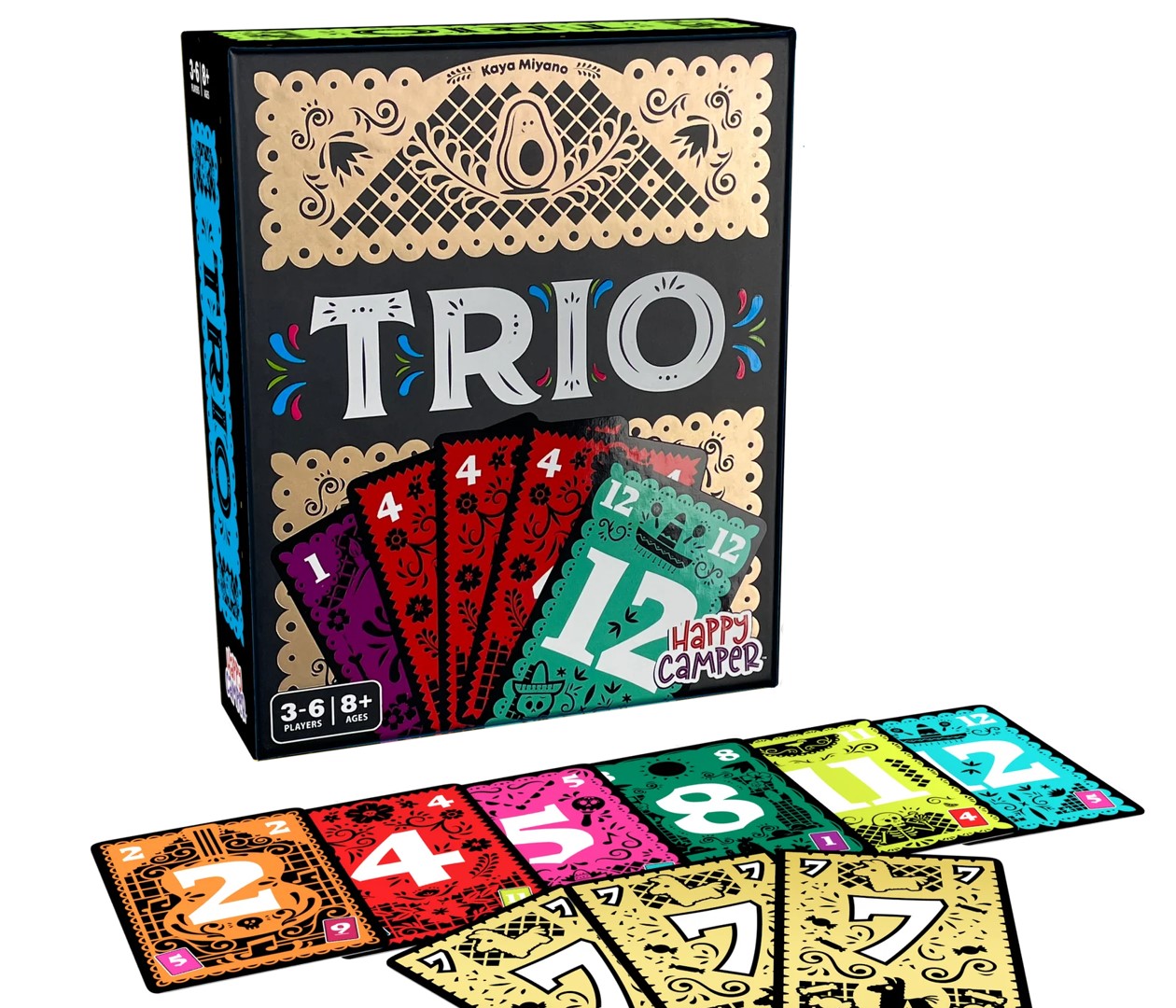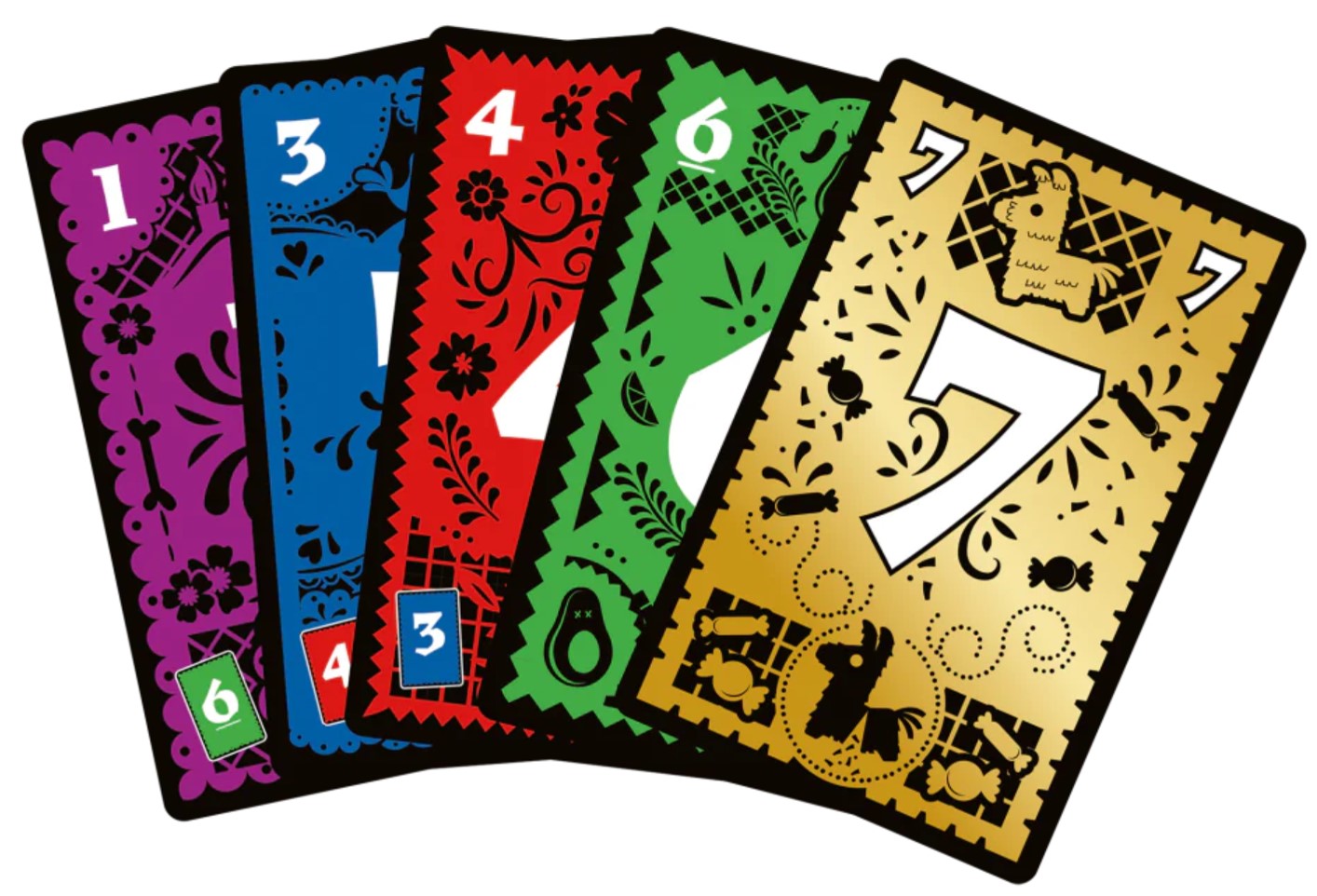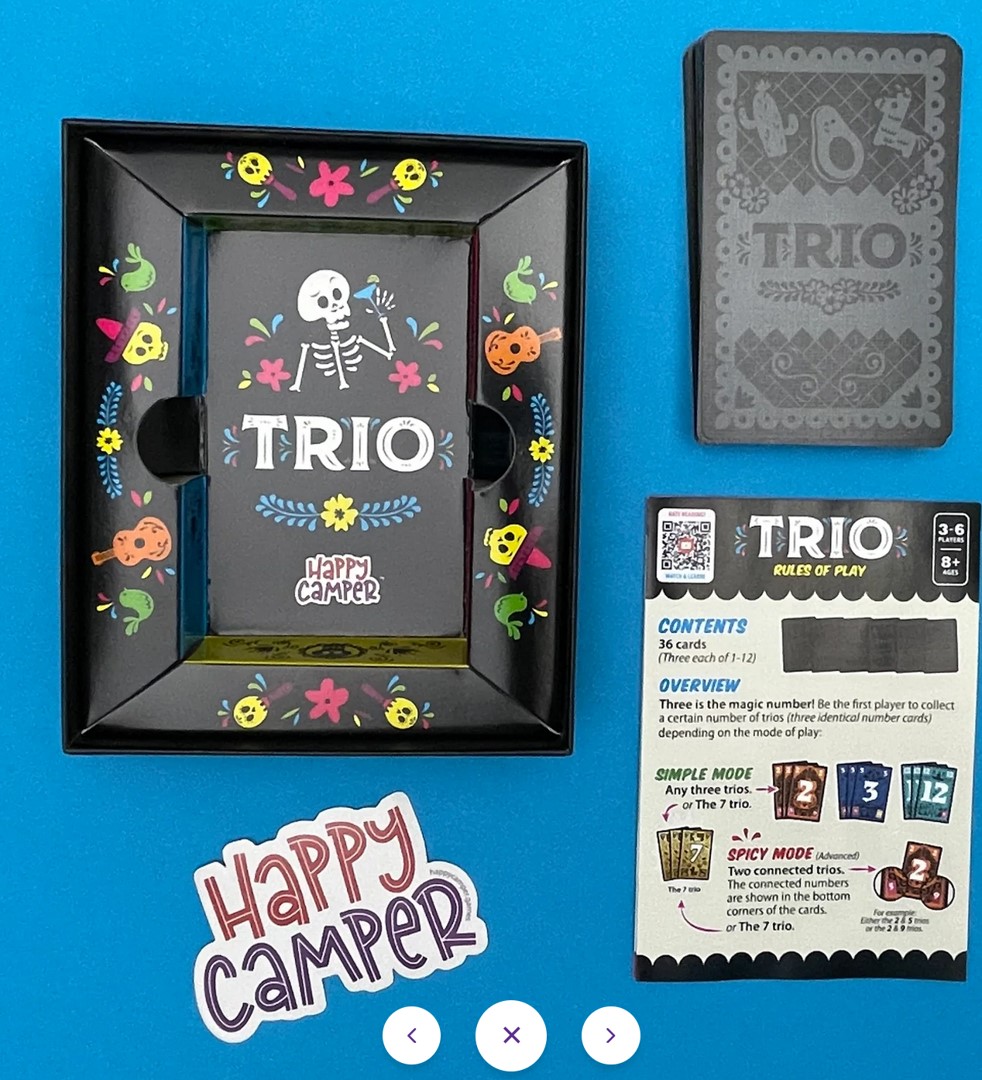I’ve played my share of Euro games and you know what? The older I get, the less patience I have to learn games with 30 page rule-books. Twenty-five year-old me would never have hesitated, but as a forty-something tired adult, I often welcome a more simpler diversion. “Trio” is such a game, featuring only 36 cards making learning the game easy. It supports 3-6 players and is appropriate for ages 8+. The average play time clocks around 15-30 minutes. Despite the game being quick and easy, make no mistake…there’s still a bit of thinking (and luck) involved if you want to pull ahead and win. Special thanks to Jason Schneider from Happy Camper Games for providing me with a copy to review. Before we begin I’m required by FTC regulations to disclose that I was paid to cover this game, but any and all opinions remain my own. The only thing paid for here was my time.
Components & Setup
The game includes 36 cards numbered 1-12 (3 each). Each number is a different color for ease of identification.
Depending on the player count, each player receives a certain number of face-down cards to form their hand. The remaining left-over cards are dealt face-down in the middle for all to access when permitted.
Players will then secretly organize their hand from lowest to highest, left to right.
The game can be played a number of different ways.
Players must decide if they want to play in SIMPLE mode or SPICY mode. This will effect the victory conditions players shoot for.
SIMPLE – Players are aiming to collect 3 TRIOS, or 3 cards of the same number a total of 3 times. A player who has acquired 1,1,1, 2,2,2, and 4,4,4 for example would win SIMPLE mode.
SPICY – Players are aiming to collect 2 CONNECTED TRIOS. Some number cards have 2 small numbers on the bottom corners. The “2” in the above photo has a 5 and 9 listed on its bottom corners. A CONNECTED TRIO are three cards that are connected via these smaller numbers. The 2, 5, and 9 is a CONNECTED TRIO.
Regardless of mode, players can also immediately win if they collect the “7” TRIO, or 7,7,7. It trumps everything.
There’s also a TEAM VARIANT mode for 4-6 players which allows teammates to swap cards with very limited forms of communication. I’ll let you discover the rest of this mode on your own.
Gameplay Overview
Whomever most recently ate something with avocado goes first (or pick a player at random) with play continuing clockwise.
For this gameplay overview, we will assume that we are playing SIMPLE mode.
On your turn you’ll attempt to find and reveal 3 of the same numbered card.
You will do 1 of the following, THEN REPEAT YOUR TURN until you mismatch two cards or make a TRIO.
1. Ask an opponent to reveal either their highest (right most) or lowest (left most) card.
OR
2. Reveal your own highest (right most) or lowest (left most) card.
OR
3. Reveal a face-down card in the middle of the table.
Note: Players will never reveal from the middle of their hands.
—
If you reveal 3 cards that are the same number without ever mismatching, congrats! You’ve won a TRIO and keep the cards in a personal victory pile.
If you draw a card that does not match the original card you picked, then all cards go back to whence they came, face-down and/or back to their owners’ hands.
In either case, your turn is over.
As indicated above, turns continue clockwise until someone reaches a victory condition as laid out in the components and setup section. Turns play out the same in SPICY mode, only the goals are different.
Note: The above doesn’t cover everything found in the rulebook, but should give you a general idea as to how the game is played.
Review
Firstly, I have to compliment the card art. Each color on the numbered cards pop and it was a good choice to make each number color unique. Color-blind folks, don’t despair…each card has unique card art and the numbers themselves are clearly visible and easy to read. The card quality is good as well…they are easy to shuffle and don’t scratch just by looking at them funny like some other card stocks do.
Gameplay was quick, making this an ideal filler game in between longer sessions. I appreciated both the SIMPLE and SPICY modes, with the former being the recommended mode if you’re new to the game. The small box size also makes it a good “vacation” type game…it’ll easily fit into a purse, suitcase, or what have you. It felt like a Gamewright / Blue Orange kinda game, which makes sense as Jason formerly worked at Gamewright. I’m very glad to see a similar theme emerge from his new umbrella, Happy Camper Games.
The rulebook could stand to be improved. I would have changed the HOW TO PLAY section to be a lot more clear as I misplayed the game originally until the developer pointed out my error. I interpreted the page as a list of things players did on their turn, going from 1 to 2, rather than the player picking one and repeating their turn if appropriate. The absence of an OR between the 1 and 2 option, for example, caused me to mentally reinforce the idea of a list. I admit I make mistakes and am partially to blame as my dyslexic & OCD mind sometimes misses something obvious. I re-worded and restructured the turn structure above to clear things up.
The player count is a bit of a disappointment. Most of the games in my collection support solo and two players. Single and two-person households are very common, so I would have liked to have seen a solo or two-player variant. In the case of the latter, perhaps adjusting the hand size and victory goals. I’m not sure how solo would be possible only because there’s a memory element to this game. At that point, you might as well just play “Concentration”.
That brings me to my other point of concern, luck and memory. It’s super important to remember who has what high/low card and what cards were already flipped in the middle (not to mention where)…it becomes a convoluted game of memory that favors those with eidetic / photographic memories. Card-counting veterans will have a leg up on those with dementia. My mother, having been diagnosed with dementia two years ago, would never be able to play this game unless I purposely picked the same cards that I knew were wrong / not a match. Even then, she’d probably get frustrated.
Don’t get me wrong, the game can be played by people of almost any age. This is a good thing. Memory games just aren’t my thing and I suspect others would be in the same boat. Some folks can also blindly luck into a TRIO, getting lucky with their card picks. One can argue however that this is not the type of game that would instill heavy competition. TRIOs come and go quickly and thus games are over before you know it. There are certain games that you just don’t mind losing in because you know the next game could swing just as easily in the other direction. “Chess”, on the other hand…well, let’s just say that I HATE losing in games of pure abstract skill. I used to take losses in Chess Tournaments very, very hard. With games like “Trio”, I accept that sometimes I’ll have no control over losing and move on.
“Trio” is priced at $15 on the game’s official website, making it on-par with other card games on the market. What’s cool is that part of their sales goes toward camp scholarships. The games themselves are ready to ship, so no waiting for years like those Kickstarter games you backed. Despite my problems with the player count and heavy focus on memory (worse with more players / more hands to remember), I find “Trio” to be a solid card game that I’d recommend with the aforementioned caveats.
Box Quote: A fast, fun little card game packed full of beautiful art and tense card-counting “recall” moments.
—
Final Verdict: 7/10 (Good)



